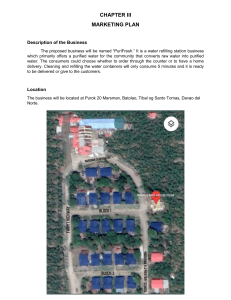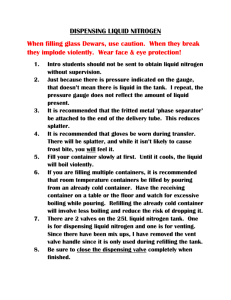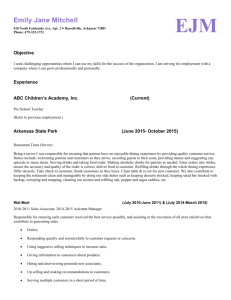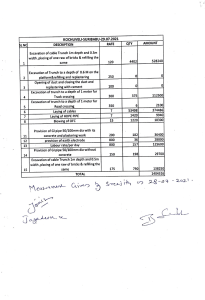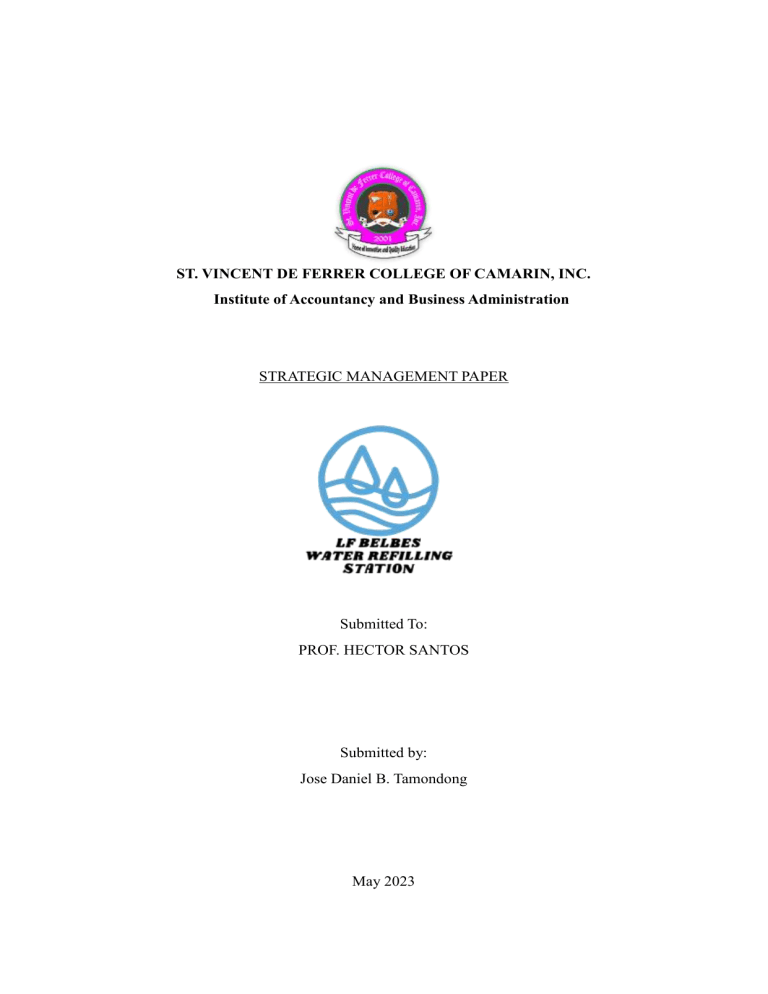
ST. VINCENT DE FERRER COLLEGE OF CAMARIN, INC. Institute of Accountancy and Business Administration STRATEGIC MANAGEMENT PAPER Submitted To: PROF. HECTOR SANTOS Submitted by: Jose Daniel B. Tamondong May 2023 1. INTRODUCTION LF Belbes Water Refilling Station was sole-proprietorship business and registered in Department of Trade and Industry (DTI) in January 2022. Initially, access to clean and safe drinking water is essential for human health and well-being. In response to this need, businesses such as LF Belbes Water Refilling Station have emerged to provide products and services related to clean drinking water. LF Belbes Water Refilling Station is a business that purifies and refills water containers, such as bottles and jugs, with safe and clean drinking water. The business offers various container sizes, including 350 ml, 500 ml, 1 liter, 5 gallons, and 10 gallons of purified drinking water. In addition to providing water products, LF Belbes Water Refilling Station also offers delivery services to customers' homes or offices, making it convenient for them to have access to clean drinking water without the need to travel to the physical store. Moreover, the business offers water testing services to ensure that the water it provides meets the highest quality and safety standards. This strategic management paper aims to investigate the marketing strategies and operational practices of LF Belbes Water Refilling Station. The business has a monthly sale between ten thousand pesos 10,000 PhP to twenty thousand pesos 20,000 PhP and primarily serves the grocery stores and canteens around the community. LF Belbes Water Refilling Station has established a strong presence in the local market by providing high-quality, safe, and convenient drinking water products and services to its customers. Through this strategic management paper, the researcher seeks to understand the factors contributing to LF Belbes Water Refilling Station's success, including its marketing strategies, operational practices, and customer service approach. Furthermore, this paper aims to provide insights for small business owners and entrepreneurs looking to start or improve their own water refilling businesses. Ultimately, this paper seeks to contribute to the body of knowledge on small business management, specifically in the context of water refilling stations, and provide valuable insights into the importance of meeting customer needs and providing high-quality products and services in today's competitive business environment. The LF Belbes Water Refilling Station was located on Block 19 Lot 2 Phase 1. Caperyork st., Greenborough subd., Sabang Dasmarinas Cavite. The business was operated by soleproprietor, Lino jr. Belbes, and as of today the business has five (5) regular employees. II. RESEARCH DESIGN AND METHODOLOGY The research design for this study will be quantitative in nature, using macro-economic data to analyze the performance of LF Belbes Water Refilling Station. The study will use secondary data sources, such as government reports and published research articles, to collect information on the Philippine economy, the water refilling industry, and the performance of LF Belbes Water Refilling Station. The study will use a combination of desk research and data analysis methods. The desk research will involve reviewing relevant literature and reports to gather information on the Philippine economy, the water refilling industry, and the performance of LF Belbes Water Refilling Station. The data analysis will involve using statistical software, such as SPSS or Excel, to analyze macro-economic data, such as gross domestic product (GDP), inflation rates, and employment rates. The study will use regression analysis to identify the relationships between macro-economic factors and the performance of LF Belbes Water Refilling Station. The study assumes that macro-economic factors, such as GDP, inflation rates, and employment rates, have a significant impact on the performance of LF Belbes Water Refilling Station. The study also assumes that the secondary data sources used in this study are reliable and valid. Finally, the study assumes that the sample size and data used in the regression analysis are representative of the population and accurately reflect the relationship between macro-economic factors and the performance of LF Belbes Water Refilling Station. Scope and Limitation The study focuses on analysing the performance of LF Belbes Water Refilling Station by using secondary data sources to examine macro-economic factors such as GDP, inflation rates, and employment rates. The study will also analyse the company's financial statements and operational data to identify trends and patterns. However, the study is limited to secondary data sources and does not include primary data collection, does not consider other factors that may affect performance, and may not reflect recent developments in the business performance. III. VISION AND MISSION STATEMENT ANALYSIS Vision Statement and Evaluation LF Belbes Refilling Water Station Vision Statement is “Our vision aims to be leading brand in the region by providing safe and affordable drinking water to communities while promoting environmental awareness and sustainable practices.” 3.1 Vision Statement Evaluation Parameter Does it clearly answer the question: What do we want to become? Yes / No Yes Is it concise enough yet inspirational? Yes Is it aspirational? Yes Does it give clear indication as to when it should be attained? No Remarks The statement clearly answers the question of what LF Belbes Water Refilling Station wants to become. It wants to become a leading brand in the region by providing safe and affordable drinking water to communities while promoting environmental awareness and sustainable practices. The statement is concise yet inspirational. It communicates the company's goals in a brief and straightforward manner while also inspiring readers with its commitment to promoting environmental awareness and sustainable practices. The statement is aspirational. It sets a high standard for the business to become a leading brand in the region, which is an ambitious goal that requires continuous effort and improvement. The statement does not give a clear indication of when the goal of becoming a leading brand in the region should be attained. However, this is not necessarily a requirement for a vision statement, as it is often a long-term goal that may not have a specific timeline. Mission Statement Analysis and Evaluation The mission statement of LF Belbes Water Refilling Station is: “Our mission is to provide safe, affordable, and environmentally friendly drinking water while promoting sustainability and responsible business practices, we believe in making safe drinking water accessible to all and strive to continuously improve our service.” 3.2 Mission Statement Evaluation Parameter Yes/No Customers Yes Product and Services Yes Markets Yes Technology No Concern for survival, growth, profitability No Philosophy Yes Self-Concept No Concern for Employees/ public image No Concern for nation building No Remarks The mission statement demonstrates a customercentric approach by emphasizing the company's commitment to providing safe and affordable drinking water and making it accessible to all. The mission statement clearly articulates the business’s goal of providing safe, affordable, and environmentally friendly drinking water while promoting sustainability and responsible business practices. The mission statement indicates the company's focus on serving communities that need safe drinking water. Not explicitly mentioned in the mission statement. Not explicitly mentioned in the mission statement, but implied through the commitment to responsible business practices. the mission statement highlights the company's philosophy of promoting sustainability and responsible business practices. Not explicitly mentioned in the mission statement. Not explicitly mentioned in the mission statement, but implied through the commitment to responsible business practices and promoting sustainability. Not explicitly mentioned in the mission statement. 3.3 Recommendations Recommended Vision “Our vision is to become the most trusted provider of safe, affordable, and sustainable drinking water solutions in the region, committed to promoting environmental awareness and fostering community well-being.” This revised vision statement is concise, inspirational, and addresses the key elements that are important to the LF Belbes Water Refilling Station. It captures the business’s aspirations and goals, while also emphasizing its commitment to sustainability, community well-being, and environmental responsibility. Recommended Mission "Our mission is to provide safe, accessible, and sustainable drinking water solutions that enhance the health and well-being of the communities we serve. We are committed to promoting environmental responsibility, fostering economic growth, and maintaining the highest standards of quality and service excellence." This revised mission statement is clear, concise, and addresses the key elements that are important to the LF Belbes Water Refilling Station. it captures the company's core values, goals, and commitment to sustainability, community well-being, and customer satisfaction. IV. EXTERNAL FACTORS THAT HAVE RELEVANCE AND MAJOR IMPACT ON WATER REFILLING INDUSTRY AND LF BELBES WATER REFILLING STATION: 4.1 General Environment a. Economic Developments Economic developments play a crucial role in the water refilling industry in the Philippines. Factors such as GDP growth, disposable income levels, and consumer spending patterns directly impact the demand for packaged drinking water. Rising incomes and urbanization have led to an increased demand for convenience and safe drinking water, driving the growth of water refilling stations. Moreover, economic stability, investment climate, and government policies on entrepreneurship and small business development also influence the industry's prospects. b. Political, Legal, Government Aspects Government Regulations The government plays a crucial role in regulating the water refilling industry in the Philippines. The Department of Health (DOH) sets standards and guidelines for water quality, safety, and packaging. Compliance with these regulations is mandatory, and failure to adhere to them can result in fines or even closure of the business. DOH Administrative Order No. 10 series of 2017 incorporates this policy, which establishes the standards and procedures for drinking water quality to safeguard public and consumer health. The PNSDW of 2017 applies to all drinking-water service providers, including government and private developers and operators, bulk water suppliers, water refilling station operators, water vending machine operators, and ice manufacturers. Additionally, it applies to all establishments, including residential, commercial, industrial, and institutional buildings, that supply or serve drinking water, as well as to water testing laboratories, health and sanitation authorities, and the general public. The guidelines conform to set standards for drinking-water quality, water sampling and evaluation of results upon examination, and are consistent with the WHO's improved framework for drinking-water safety, which consists of health-based targets, safely managed water systems, and a system of independent surveillance. To ensure drinking water safety, there are seven guidelines that must be followed, which include measuring quality, water sampling and examination, evaluating results, classifying quality parameters, and implementing quality assurance/quality control for water laboratories, as well as a water safety plan and quality surveillance. To implement this policy, various government, and non-government agencies, including DOH, local government units, water laboratories, and drinking-water service providers and operators of establishments or buildings, have partnered, each with a defined role in the undertaking. https://doh.gov.ph/node/12121 Institutions and policies The Department of Health (DOH), which is tasked with safeguarding public health, is the primary agency responsible for protecting the quality of drinking water. The Sanitation Code of the Philippines mandates DOH to issue implementing rules and regulations that prescribe sanitary standards for water supply systems, including water refilling stations. The Center for Health Development (CHD), the regional branch of DOH, provides technical assistance to local government units and monitors the implementation of DOH programs, including water quality and sanitation standards. For water refilling stations, CHD is authorized to issue initial and operational permits. Local Government Units (LGUs) are mandated by Presidential Decree (PD 856) to issue various permits and conduct sanitary inspections of water refilling stations, including sanitary permits, clearance, health certificates, certificate of potability, drinking water site clearance, closure order (if necessary). The Water Quality Association of the Philippines Inc. (WQAP) is a private organization composed of 250 members engaged in the manufacture, sale, and distribution of water refilling station equipment and supplies, as well as water treatment and purification equipment and technology. About 85% of its members operate water refilling stations. The Association of Water Refilling Entrepreneurs (AWARE) focuses on resolving business management issues faced by its members. The Sanitation Code of the Philippines or Presidential Decree No. 856 (PD 856) is the primary law mandating all establishments to comply with existing sanitary standards to protect public health. The Supplemental Implementing Rules and Regulations on Water Supply of PD 856 issued in 1999 provides guidelines for operating a water refilling station. c. Social Factors The water refilling industry in the Philippines is not only influenced by economic and technological factors but also by various social factors. These factors encompass cultural norms, consumer preferences, health consciousness, and the perception of water quality and safety. This essay explores the relevance and major impact of social factors on the water refilling industry in the Philippines, shedding light on how these factors shape consumer behavior, industry trends, and business strategies. Cultural Norms Cultural norms significantly impact the demand for water refilling services in the Philippines. Traditional beliefs and practices related to water consumption vary among communities and regions. Some communities may prioritize traditional water sources, such as deep wells or natural springs, due to cultural significance or perceived purity. In contrast, other communities may be more open to accepting packaged drinking water as a convenient and reliable alternative. Understanding cultural norms is crucial for water refilling businesses to tailor their services and marketing strategies to specific target markets and promote cultural acceptance of their products. Consumer Preferences Changing consumer preferences play a vital role in shaping the water refilling industry. Consumers are increasingly seeking convenience and ready-to-drink products, driven by busy lifestyles and the need for accessibility. Water refilling stations provide a convenient solution by offering purified drinking water that can be easily obtained and consumed. The preference for affordability, reliable sources of safe drinking water, and reduced plastic waste also contributes to the demand for water refilling services. By aligning their offerings with consumer preferences, water refilling businesses can attract a wider customer base and maintain a competitive edge in the market. Perception of Water Quality and Safety The perception of tap water quality and safety also influences the demand for water refilling stations. Concerns about water contamination, taste, or odor can lead consumers to seek alternative sources of drinking water. Water refilling stations, with their emphasis on thorough filtration and purification processes, are perceived to provide a higher level of water quality and safety compared to tap water. Effective marketing campaigns highlighting the stringent quality control measures, certifications, and regular testing can help alleviate consumer concerns and build trust in the reliability of water refilling stations. Health and Wellness Trends The growing focus on health and wellness has a positive impact on the water refilling industry. Proper hydration and water intake are recognized as essential for maintaining overall health and well-being. As consumers become more health-conscious and prioritize hydration, they seek reliable and accessible sources of purified drinking water. Water refilling stations, offering convenient access to purified water, cater to this growing trend and position themselves as a preferred choice for health-conscious individuals. Collaborations with fitness centers, health clubs, and wellness establishments can further leverage this trend and create synergistic partnerships. d. Opportunities Increasing Health Consciousness The growing emphasis on health and wellness presents a significant opportunity for water refilling stations. Consumers are increasingly aware of the importance of drinking safe and purified water for their well-being. By promoting the health benefits of purified water and positioning themselves as a reliable source of clean drinking water, water refilling stations can tap into the expanding health-conscious consumer segment. Rising Demand for Convenience The fast-paced lifestyle of urban dwellers in the Philippines has led to a rising demand for convenient solutions, including access to safe drinking water. Water refilling stations offer a hassle-free and time-efficient option for consumers to obtain purified water. By strategically locating their stations in densely populated areas or near workplaces, water refilling businesses can cater to the convenience-seeking behavior of consumers and capture a larger market share. Increasing demand of water refilling stations and stores that sell purified water (opportunity) Water refilling stations, which sell purified water that conforms to national drinking water standards and has fewer impurities than traditional water systems, are experiencing an increase in demand. This is due to the rising cost of household water purifiers and bottled water, making water refilling stations managed by private entrepreneurs a more affordable and convenient option. Nationwide, there are approximately 3,000 water refilling stations that offer purified water of comparable quality to bottled water at a lower price, ranging from P 50 to P 120 per 5-gallon container or about P 2.50 to P 6.00 per liter in Metro Manila. Most water refilling stations in Metro Manila are connected to the pipes of two concessionaires, Maynilad Water Company or Manila Water Company, for their source of raw water. Private deep wells are used in other areas. The water is further purified using various water treatment equipment, and typical water refilling stations can produce 3,000 to 12,000 liters of purified water per day. To accommodate the convenience of consumers, purified water is now delivered directly to people's homes in 5-gallon containers. For instance, Aqua Sure, a water refilling station in Metro Manila, can deliver 5,500 gallons (25,000 liters) of purified water per day to its 8,000 household clients. Environmental Sustainability With increasing concerns about plastic waste and environmental conservation, there is a growing demand for sustainable solutions in the water industry. Water refilling stations have the opportunity to position themselves as environmentally friendly alternatives to single-use bottled water. By offering refillable containers or eco-friendly packaging options, businesses can attract environmentally conscious consumers who seek sustainable and responsible choices. Collaboration with Health and Fitness Establishments Collaborating with gyms, fitness centers, wellness retreats, and health-oriented establishments can create mutually beneficial partnerships for water refilling stations. By positioning themselves as the preferred water provider for health-conscious individuals engaged in fitness and wellness activities, water refilling stations can gain exposure to a targeted consumer base. This collaboration can include cross-promotions, joint marketing initiatives, or exclusive partnerships to maximize brand visibility and customer acquisition. Expansion into Underserved Areas While water refilling stations are prevalent in urban areas, there are opportunities for expansion into underserved or rural areas in the Philippines. Many remote communities still lack access to clean drinking water. By establishing water refilling stations in these areas, businesses can fulfill a vital need while creating sustainable business opportunities. Collaboration with local governments or NGOs can facilitate market entry and provide support in infrastructure development and community engagement. Technological Advancements Embracing technological advancements can enhance the efficiency, convenience, and overall customer experience of water refilling stations. Implementing automated processes, online ordering platforms, and digital payment systems can streamline operations and attract tech-savvy consumers. Additionally, investing in advanced water treatment technologies can improve water quality and differentiate businesses in the market. Technological advancements impact the water refilling industry by improving water treatment processes, enhancing operational efficiency, and ensuring product quality and safety. Innovations in filtration systems, disinfection technologies, and quality monitoring systems enable water refilling stations to provide purified and safe drinking water to consumers. Moreover, advancements in automated processes, digitalization, and online platforms for ordering and delivery services have transformed the industry's operations and customer experience. Catering to Cultural Preferences Recognizing and catering to cultural preferences can be a key opportunity for water refilling stations in the Philippines. Different communities may have specific preferences for container sizes, packaging materials, or traditional water sources. Adapting offerings to align with cultural norms and local preferences can help businesses gain acceptance and build strong customer loyalty within those communities. Educating Consumers There is an opportunity for water refilling stations to educate consumers about the importance of drinking safe and purified water. By providing informative resources, organizing awareness campaigns, or conducting water quality testing events, businesses can build trust, raise awareness, and position themselves as industry leaders. Educating consumers about the advantages of choosing water refilling stations over other alternatives can drive market demand and create a loyal customer base. Value-Added Services Water refilling stations can differentiate themselves by offering value-added services that go beyond providing purified water. This can include additional services such as home delivery, water quality testing, or personalized water treatment solutions for specific customer needs. By diversifying their offerings, businesses can attract a wider customer base and increase customer loyalty. e. Ecological Aspects Ecological factors are increasingly relevant to the water refilling industry in the Philippines. As consumers become more environmentally conscious, there is a growing demand for eco-friendly practices and sustainable packaging solutions. Water refilling stations that implement water conservation measures, promote reusable containers, and minimize plastic waste are likely to attract environmentally conscious consumers. Additionally, concerns related to water scarcity, pollution, and climate change highlight the need for sustainable water management practices in the industry. Demographics The Philippines is rapidly urbanizing, and the growing cities struggle to provide new residents with adequate water and sanitation services. This presents an opportunity for water refilling stations to expand their market. The middle-class population in the Philippines is growing, and they have become more health-conscious, creating a demand for safe drinking water. Water scarcity in the Philippines (threats) The availability of clean and safe water is critical to the water refilling industry. Drought, contamination, and over-extraction of groundwater are some of the factors that can affect the availability and quality of water. Philippines has, 52% of its 109 million population, or 57 million people, do not have access to a dependable and safely managed water source, while 39% or 43 million people lack safely managed sanitation facilities. Despite economic growth, the Philippines still faces considerable obstacles in addressing the issue of water and sanitation accessibility. Urbanization is rapidly expanding, and cities are encountering difficulties in accommodating the needs of new residents by providing adequate water and sanitation services. 4.2 Industry and Competitor Analysis Porter’s Five Forces Competitive Analysis Porter's five forces framework is a widely used tool to analyse the competitive environment of an industry. Here is an analysis of the water refilling industry in the Philippines using the framework: Threat of New Entrants In the case of the water refilling industry in the Philippines, this threat is high. One reason for this is that the industry has relatively low entry barriers. Unlike other industries that require significant investment in technology, manufacturing equipment, or distribution channels, starting a water refilling station requires relatively low initial capital investment. This makes it easier for new players to enter the market and compete with existing players. Additionally, the high demand for clean and safe drinking water creates an attractive market for new entrants. With growing concerns about the safety and quality of tap water in the Philippines, there is a constant need for reliable sources of purified drinking water. This demand presents a significant opportunity for new players to enter the market and capture market share. Overall, the low entry barriers and high demand for purified water make the threat of new entrants in the water refilling industry in the Philippines high. Existing players will need to continually innovate and differentiate their offerings to maintain their market position in the face of new competition. Bargaining Power of Suppliers The water refilling industry relies on three main inputs: water, electricity, and filtration equipment. The suppliers of these inputs are fragmented, which means that there are many suppliers available in the market. This fragmentation in the supplier base reduces the bargaining power of individual suppliers, as water refilling stations can easily switch from one supplier to another. Additionally, the water refilling industry has low switching costs, which means that it is relatively easy and inexpensive for water refilling stations to switch from one supplier to another. For example, if a water supplier increases its prices, a water refilling station can easily switch to a different supplier without incurring significant costs or disruption to its operations. Overall, the fragmented supplier base and low switching costs reduce the bargaining power of suppliers in the water refilling industry. As a result, suppliers are less able to exert influence over the industry and its prices. Therefore, the bargaining power of suppliers is considered low. Bargaining Power of Buyers In the water refilling industry, the buyers are households, offices, and other commercial establishments that purchase water from refilling stations. These buyers are not concentrated and they do not have significant influence over the price or quality of the water supplied by refilling stations. Moreover, the cost of switching between water refilling providers is low, and the product is undifferentiated, which further weakens the bargaining power of buyers. With low switching costs, buyers can easily switch to other refilling stations that offer better prices or quality. In addition, the product offered by one refilling station is not significantly different from that offered by other stations, which reduces buyers' ability to demand better quality or features. In conclusion, due to low switching costs, undifferentiated products, and dispersed buyers, the bargaining power of buyers in the water refilling industry is low. This means that the industry can charge a reasonable price for its product without the fear of losing a significant number of buyers. Threat of Substitutes In the case of the water refilling industry in the Philippines, the main substitutes for water refilling stations are bottled water and home filtration systems. Bottled water is a popular substitute for water refilling stations because it is widely available and easy to transport. However, it is more expensive than water refilling stations, which may make it less attractive for price-sensitive consumers. Home filtration systems are another substitute for water refilling stations, as they allow consumers to purify their own tap water at home. However, these systems require an initial investment in equipment, which may not be affordable for some consumers. Therefore, the threat of substitutes for the water refilling industry in the Philippines is considered moderate. While there are substitutes available, they may not be as convenient or cost-effective as water refilling stations. However, if prices for water refilling stations were to rise significantly, or if consumers were to become more concerned about the environmental impact of plastic bottles, the threat of substitutes could increase. Rivalry Among Existing Competitors The water refilling industry in the Philippines is characterized by high competition with numerous small and medium-sized enterprises competing for market share. These enterprises have a low level of product differentiation, leading to intense price competition. As a result, the industry lacks a dominant player, and each firm has a relatively small market share. The low switching costs for customers also contribute to the high level of competition among existing competitors. Moreover, the water refilling industry has low entry barriers and attracts new entrants. This situation exacerbates the competition among existing players, forcing them to maintain or reduce their prices to remain competitive. Overall, the high level of competition among existing players in the water refilling industry in the Philippines is driven by the lack of product differentiation, intense price competition, and low switching costs for customers. As a result, firms need to focus on operational efficiency and cost reduction to remain competitive. Conclusion In conclusion, the water refilling industry in the Philippines is highly competitive, with low barriers to entry and intense price competition among existing players. While the bargaining power of suppliers and buyers is low, the threat of new entrants is high. The threat of substitutes is moderate. To succeed in this industry, players need to focus on operational efficiency, cost control, and product differentiation. Additionally, the industry is highly regulated, and compliance with regulations is critical to maintaining a good reputation.

